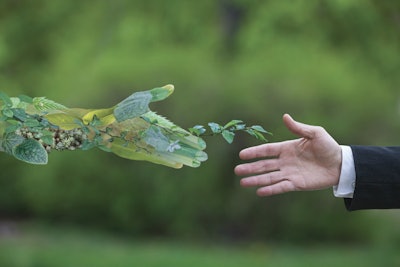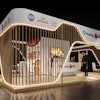
As retail and foodservice succumb to consumer and animal rights pressure to go Net Zero, implications are felt throughout the entire poultry supply chain.
But sustainability shouldn’t be a scary concept for the poultry industry.
“Everything is connected. We understand that our economic domain is fully integrated with the social domain, which is fully dependent on the ecological domain. Anyone who is living in a rural community understands that if the ecological domain is disrupted, the social domain and the economic domain collapse,” explained Marty Matlock, Ph.D., professor of ecological engineering, Biological and Agricultural Engineering Department, University of Arkansas.
At the 2022 Poultry Tech Summit, Matlock addressed the challenges and opportunities of going Net Zero for the poultry industry.
Sustainability improvements 1950-2010
U.S. greenhouse gas emissions from agriculture makes up less than 5% of the global agricultural greenhouse output.
In addition, there have been significant improvements in poultry production between 1960 and 2010, according to Matlock’s research. His data measured everything from feed rations to bird characteristics in poultry production.
Crops now require less land to produce the same amount of poultry feed. Irrigation water use increased for all crops, except for wheat. Modern broilers also have a decreased production length and better feed conversion.
“What we’ve done is decrease the barriers to yield while increasing yield overall,” he explained.
Some environmentalists criticize poultry production’s expansion over this time period. It’s true that the industry uses more land than before, but there’s an explanation for that – the global population is growing.
How to improve sustainability going forward
Feed is typically considered one of the biggest contributors to greenhouse gas emissions in the poultry supply chain. This means that poultry producers who want to go Net Zero or further improve sustainability should ensure that they have a close relationship with their food producer.
Regenerative agriculture – which maximizes soil diversity – is one of the new technologies that Matlock is most excited about when it comes to improving the sustainability of poultry feed production.
Other ways that could help the poultry industry achieve Net Zero include an increased feed conversion ration through better digestibility, feed additives that improve nutrient uptake by the gut and diet optimization. Welfare initiatives can also help because a better bird is a healthier bird.
“When people talk about regenerative agriculture, don’t get your hackles up,” he added, noting that many of these principles are already in use.
Attend the 2023 Poultry Tech Summit
Join an exclusive international gathering of industry-changing innovators, researchers, entrepreneurs, technology experts, investors and leading poultry producers at the 2023 edition of Poultry Tech Summit on November 6-8 at the Hilton Atlanta Airport in Atlanta, Georgia.
Attendees can expect the same groundbreaking innovation and insightful presentations that made the previous events well-attended with deep dialogue on new prospective solutions and next-generation technologies. Poultry Tech Summit focuses on the transition of innovative technologies into commercial applications to advance the poultry industry.
Registration for this event will open in the spring of 2023.


















